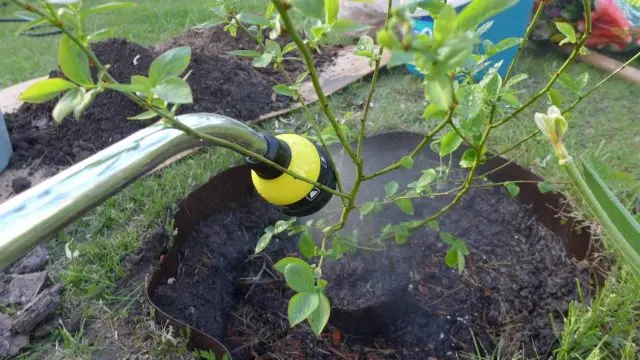Contents
Transplanting blueberries in the fall to a new place is an important and crucial stage. The further development of the shrub depends on its implementation. So that the plant does not suffer during transplantation, it is important to find a suitable place for it and prepare the substrate. The shrub quickly adapts to new conditions if it is provided with good care.
In what cases is it necessary to transplant blueberries to another place
In nature, a blueberry bush grows up to 100 years in one place. Cultural forms planted in a dacha or garden plot bear fruit for 50-60 years. However, the plant does not always take root well in a new place. Then it is necessary to transplant shrubs.
The need to transplant blueberries to another place often appears in the following cases:
- external factors (growth of neighboring trees and shrubs, changes in landscape design, etc.);
- soil depletion;
- shrub rejuvenation;
- culture reproduction.
Gardeners have to replant garden blueberries if the wrong site has been chosen for them. For example, when planting, the substrate was not prepared, and the plant develops poorly. In addition, the site can be flooded with melt water in the spring, which leads to the death of the shrub.
Blueberries can suffer from external influences. If nearby crops grow rapidly, they inhibit the development of other plants. As a result, blueberries do not receive enough light and nutrients.
If blueberries grow too long in one place, then the soil is gradually depleted. This negatively affects the growth of the shrub. In such situations, transplanting and preparing a new substrate for culture helps.
Over time, the shrub ages and brings less yield. It helps to save the situation by transplanting a bush and dividing it into parts. As a result, several new seedlings are obtained. This is how culture is rejuvenated.

When is the best time to transplant blueberries?
There are several options when you can transplant blueberries to another place. Each of them has its own advantages and disadvantages, which are taken into account before starting work. Specific dates are chosen taking into account weather conditions and the condition of the bush.
The most preferred transplant is in early spring or late autumn. During such periods, the plant best tolerates changes in external conditions. Transplantation in the summer is also possible, but has a number of limitations.
For a spring transplant, choose a period when the snow melts and the soil warms up. It depends on the climate in the region and weather conditions. In the south, work is carried out until the end of March, in the middle lane – in April. In colder climates, transplanting is done in May.
Without restrictions, you can transplant blueberries in the spring in the middle lane, in the North-West, the Urals and Siberia. It is recommended to perform work before bud break. If you are late with the deadlines, then it will take more time to adapt.
Benefits of spring planting shrubs:
- have time to adapt to a new place;
- there is no risk of cold weather;
- the ability to care for the shrub during the season.
Spring planting has several disadvantages:
- the growing season may begin earlier than suitable weather conditions;
- if spring frosts are predicted, then work will have to be postponed until autumn or a shelter should be built for the shrub;
- the plant is provided with complete care: watering, fertilizing, mulching.
Summer transplanting shrubs is not the best option. If you disturb the plant during the growing season, it will disrupt its life rhythm. The procedure is especially dangerous during the period of flowering and ripening of berries. If it is necessary to transplant the bushes in the summer, then the crop is completely removed first.
Summer transplants are best tolerated by young bushes that have not yet begun to bear fruit. Usually on the bushes of the first berries ripen in the 2nd – 4th year after planting. If you transplant a five-year-old blueberry in the summer, then the plant will direct its forces to adapt to new conditions. It is highly likely that next year the yield will be minimal.
The main advantages of a summer transplant:
- the berry plant will not suffer from frost;
- suitable for working with plants in containers.
Cons of transplanting blueberries in summer:
- the growth and development of the bush is disturbed;
- the plant needs more strength to adapt.

Autumn transplantation is practiced in the south. Work is carried out in November, 2-3 weeks before the onset of cold weather. In other regions, bushes are transplanted in October. At the same time, they wait for the end of the growing season, when the leaf fall passes. If frosts are predicted in the region, then it is better to postpone the transplant until spring. There is a high probability that blueberries will die under the influence of cold.
In autumn, the plant goes into a dormant period and tolerates transplanting well. At the same time, the root system continues to grow in blueberries. Therefore, by the beginning of winter, she has time to adapt to new conditions.
Benefits of transplanting blueberries in the fall:
- high survival rate of bushes;
- the adaptation period will take place in the fall, and in the spring blueberries will immediately begin to grow;
- after transplantation, plants require minimal care: enough watering and shelter for the winter.
Disadvantages of autumn transplant:
- blueberries can suffer from a sharp cold snap;
- in winter, bushes are more likely to be damaged by rodents;
- for young bushes provide shelter for the winter.
How to transplant blueberries
When transplanting blueberries, it is important to consider a few nuances. A suitable place is chosen for the culture, after which the substrate is prepared. The order of work does not depend on the time of year and remains unchanged.
Site selection and soil preparation
Blueberries are transplanted to a sunny place, away from large trees, buildings and fences. In the shade, the bush grows slowly, its productivity decreases, and the berries do not gain sugars. Areas in the lowlands where moisture and cold air accumulate are not suitable for transplanting.
Pay special attention to the pH level of the soil. The optimal indicator for culture is from 3,5 to 5. It is measured using a special device. If the acidity of the soil is insufficient, a special substrate is prepared.
After transplanting, blueberries grow well in acidic peat. Softwood bedding, wood chips, rotted sawdust, and coarse sand are added to the substrate. A hole is dug in the chosen place. Its dimensions depend on the size of the bush. Usually, a pit 60 cm deep and 1 m in diameter is suitable for transplantation. The walls of the pit are insulated with polyethylene or tin sheets.
If the site has dense soil, then it is required to create a drainage layer. Crushed stone, expanded clay, broken brick are suitable for him. Drainage is poured to the bottom of the landing pit. As a result, a layer 10–15 cm thick is obtained. Then the prepared substrate is transferred into the pit.

How to transplant blueberries
To transplant blueberries to a new place, follow the instructions:
- Prepare the planting pit and substrate. The bush is planted on a small hill or ridge.
- Blueberries are inspected, old or dry shoots, young shoots are removed. The remaining branches are cut in half.
- They retreat 20 cm from the center of the bush and dig it in from all sides.
- The plant is taken out of the ground. No need to pull it by the shoots: this can seriously damage the blueberries.
- To protect the roots, they are wrapped in a tarpaulin.
- The shrub is transferred to the prepared pit.
- The bush is placed on the comb, its roots fall asleep and watered abundantly.
- The earth is mulched with peat.
Blueberries are also transplanted into containers. They are placed on the veranda, gazebo or terrace. In this case, a large ceramic container or a wooden box is prepared for transplantation. Be sure to make drainage holes and pour small stones to the bottom. Sour peat is prepared for the culture. After transplantation, the plant is watered, and rotted coniferous litter is poured into the near-trunk circle.
Care for blueberries after transplantation
If the transplant took place in the fall, then the plant is no longer watered or fed. The flow of moisture and nutrients stimulates the development of the bush. Before the onset of cold weather, it is prepared for winter: spud and mulch with peat. Above the young blueberries, a frame is constructed, to which any non-woven fabric is attached.
If blueberries are transplanted to a new place in the spring, then they provide good care. Watering and fertilizing begin after 2 – 3 weeks. During this time, adaptation to new conditions takes place.
In the future, the bush is watered 1 – 2 times a week. At the same time, they do not allow drying of the soil and stagnation of moisture in the soil. Mulching the soil with peat or pine needles helps maintain an optimal level of humidity.
After transplanting in the spring, blueberries are fed with ammonium sulfate or urea. 10 g of fertilizer is added to 10 liters of water. When flowering and fruiting, they switch to potassium sulfate and superphosphate. A large bucket of water requires 30 g of each substance. It is convenient to use complex fertilizers for the crop, which contain all the necessary substances.

Conclusion
Transplanting blueberries in the fall to a new location will help improve the conditions in which the shrub grows. It is best to carry out the procedure in autumn or spring. In some cases, summer transplantation is allowed. Beforehand, a site is prepared for the culture: they dig a hole and introduce deoxidizers.









